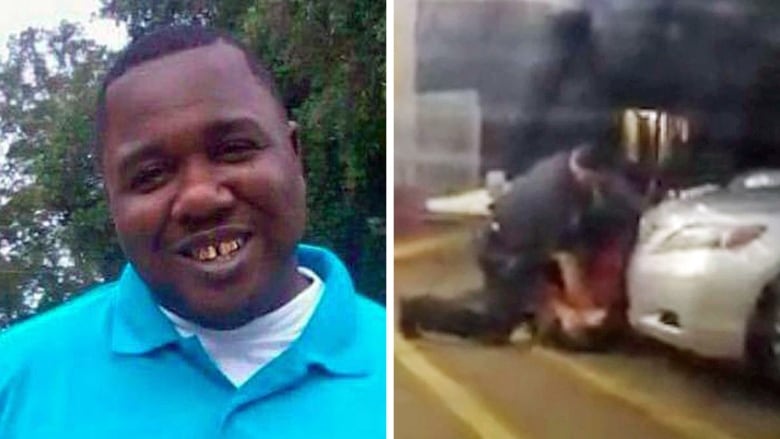Alton Sterling shooting: A quick death, a swift federal probe
Advocates surprised by Department of Justice's immediate intervention

GRAPHIC CONTENT WARNING: New video emerges showing killing of Alton Sterling
Another deadly police shooting of a black man, another incident caught on cellphone video, another call from politicians for peace in the streets.
But this time, the anguished family of the victim, 37-year-old Alton Sterling, is getting something that criminal-justice analysts say isn't so common in these tragedies an immediate federal investigation into his death.
It all unfolded so quickly in Baton Rouge, says Tracy Andrus, a Louisiana native and the director of the criminology institute at the historically black Wiley College in Texas.
"Everything from the release of the footage to even getting the names of the officers," Andrus says. "This is absolutely unusual. Normally, the feds and the Department of Justice don't move this quick."

Two white officers identified as Blane Salamoni and Howie Lake II encountered him following a tip from an anonymous caller that a man in a red shirt had threatened him with a gun.
Cellphone footage of the altercation shows Sterling being pinned to the pavement. Someone yells, "He's got a gun!" and then several gunshots are heard.
A second video, shot by the store owner from a closer angle, was released Wednesday evening. The new footage appears to show that Sterling was not an active threat, despite having a gun. Louisiana is an open-carry state.
Warning: This video, taken by the store's owner, contains disturbing images and graphic language.
Within 36 hours of Sterling's death, Edwards announced that the Department of Justice would be launching a civil-rights investigation into the slaying. To civil rights advocates, it was a clear demonstration of a desire for an open and transparent truth-seeking process.
On Thursday, it was learned that Sterling had a criminal record includingfelony convictions which meant he couldn't legally carry a firearm.
As much as Amnesty International welcomes the third-party intervention, Jamira Burley says the briskness of the action speaks to an increasingly troubling familiarity with these kinds of tragedies.
"We as a society have become so much more accustomed to responding to acts of violence, and not looking at how we can be preventative to ensure they don't happen again," says Burley, Amnesty's manager for gun violence and criminal justice reform.
No special treatment for officers

Recent cases of lethal use of police force have drawn scrutiny when local law enforcement were put in charge of investigating themselves. The 2014 shooting of 12-year-old Tamir Rice in Cleveland was one example of a case that resulted in no indictments of the officers involved.
In the Sterling case, a federal probe could keep accusations of special treatment at bay.
Were the municipal police in charge of the investigation, Louisiana's Police Bill of Rights would have granted the officers a 30-day grace period before interrogation.
Such allowances could breed further mistrust.
In Burley's experience, achieving third-party intervention in these shootings typically takes a lot more public pressure.
"We've just never had the Justice Department take over an investigation this fast," she says.

On April 4, 2015, for example, a cellphone video captured 50-year-old Walter Scott being shot in the back while running away from a police officer in North Charleston, S.C. The Justice Department opened an investigation into the matter after three days ofgrassroots advocacy, a development that was notable at the time for how quickly it came together.
The Aug. 9, 2014, shooting of 18-year-old Michael Brown by a white officer in Ferguson, Miss., prompted an FBI civil-rights investigation two days after Brown's death. But the Aug. 11 probe was called only after a wave of anti-police unrest that began the night of the shooting.
- Walter Scott shooting: Former South Carolina officer indicted on federal charges
- Michael Brown shooting: Rioting, looting erupts after peaceful vigil
In his remarks on Wednesday, the Louisiana governor urged continued peace and calm.
"Another violent act or another family torn apart is not the answer," John Bel Edwards said, in a bid to quell potential rioting fuelled by distrust of the police force in the black community.
Delayed federal investigations
Louisiana congressman Cedric Richmond pointed to delayed federal investigations in the Bayou State in the past, telling CNN of a "big distrust that justice will be served" following the Henry Glover and Danziger Bridge shootings, which occurred in the aftermath of 2005's Hurricane Katrina in Orleans.
Glover, an unarmed 31-year-old, was shot by a New Orleans police officer. Another officer burned his body.
The Danziger Bridge police shootings involved the killing of two unarmed civilians, James Brissette and Ronald Madison.
"It took protests and it took a family fighting for years and years," Richmond said. "And the FBI finally came in and uncovered that a number of police officers executed two men in cold blood."

Federal intervention is seen as one positive development. At one time, before the ubiquity of mobile video recording devices, video evidence might have also been seen as a "foolproof" way to curb unjustified use of deadly police force, says Lori Martin.
The assistant professor of African and American Studies at Louisiana State University noted that body cameras on officers were touted as a possible technological solution to improving police accountability.
"But what we're hearing [in the Sterling case] is they may have fallen off, or been inoperable," Martin says. "That, to me, says that while body cams and dashboard cameras may help in some instances, this just points to the fact that we're just trying to find a band-aid for a festering sore."













_(720p).jpg)


 OFFICIAL HD MUSIC VIDEO.jpg)
.jpg)



























































































